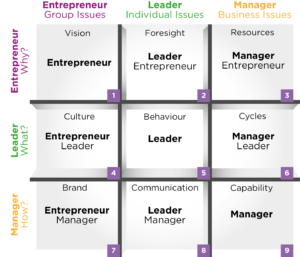Whether the impact is Brexit, a global pandemic or a lack of innovation, to make business change effective, a team needs to be aligned and pulling together in the same direction, leveraging the entrepreneur’s (E) vision for the future, the leader’s (L) plan for tomorrow and the manager’s (M) process for the needs of today.
The primary context of the Shirlaws ELM indicator is to support you in understanding more about your natural role by providing awareness of your inclination towards Entrepreneurial, Leadership and Management activities. Unlike personality tests that remain fairly constant, our indicators reflect current behaviours within your business and personal life.
Having stated that our changing behaviours can influence where we appear on the indicator, overall people have a natural inclination towards certain types of roles and behaviours. The ELM Indicator is designed to help people gain a greater understanding of how their attitudes and aptitudes support them in their current role and influence the choices they make in response to business and personal issues and the people they interact with. Within an organisation, using the ELM matrix, we can map where everyone in the organisation is situated and identify gaps where skill sets will be needed as the business plans for change.

Each section of our model, the ELM matrix, is called a change ‘drawer’. Think of the game tic-tac-toe, or noughts and crosses – one step away from a drawer supports the change, while two steps away (a gap) become blockers.
Let’s use the example of resources to illustrate the point. The three areas close to the top right resources drawer will support this project, while the other five are blockers or detractors that will slow the resources project down. For example, capability is clearly a constraint to resources.
Implementing any corner drawer will only have three helping drawers, but five hindering. In project management terms, it’s helpful to spot quickly the supporting business areas and which blockers to address.
Matching people to tasks
The model becomes particularly useful when appointing individuals to run projects. Putting your change initiative into its corresponding drawer suggests how to match different people profiles for a more successful outcome.
Leader profiles are effective in all nine change drawers because the leader profile touches each square. Leaders are the most adaptable and can even reach into the four corner squares.
The entrepreneur and manager profiles only reach some drawers, with the rest being out of their grasp. This logic explains why entrepreneurs and managers struggle at times with change programmes – and offers some clues about how, and where, to engage them more effectively in implementation.
Profiles in action
We recently witnessed a resources project being run by a person with a strong entrepreneur profile (top left). Our client soon realised it would be more successful being run by a manager – top right, same square as the resources ‘drawer’.
The HR director of a large telco described to us a major implementation problem in a culture change programme. It turned out that the person delivering the project has a managerial profile – bottom right. “We thought it’d be good to have them run this project as they’d often blocked things in the past,” said the HR director. After discussing the implications of the person’s profile, the director realised why a different individual would be preferable in this instance.
We have worked with a number of companies that were started by entrepreneurs and then stalled. Why is this? Well the entrepreneur is great at the vision but often poor at implementing which is why we often see a change in leadership once a company matures.
Conversely it is incorrect that the CEO has to be entrepreneurial. We have a client where the CEO is a strong manager who has never really wanted to be the leader. Armed with ELM we are working on the functional responsibilities for his team in order to better support him so that he can do what he does best – deliver projects on time and on budget while others lead the sales and marketing functions.
Earlier we mentioned how your appearance on the ELM matrix can change over time due to a change in behaviours. An example of this is a reassessment of a client who completed an ELM two years earlier at a time when both business partners were putting the foundations of the business in place. Unsurprisingly, both partners showed up as managers; 24 months later however, one of the partners continues to spearhead the running of the business with the other taking up a more entrepreneurial stance, reflecting their change of focus.
On many occasions we leverage more than one indicator. Recently we had a situation where the CEO of a technology was a pure entrepreneur and a high feel (TFK Indicator) and the rest of the team were managers and high think. The result was a company full of ideas but very little follow through and a failing culture driven in large part by poor communication. Dialogue around the conflicting profiles allowed us to implement functionality and culture projects.
Hopefully you have gained some insight into the ELM indicator, both with the theory and some practical examples, and can see how it can be effectively used to support the process of change. To learn more please visit www.shirlawscompass.com
Nigel Hartley is a Business Advisor with Shirlaws Group and also a Director of Shirlaws USA. You can contact Nigel on nigel.hartley@shirlawsgroup.com.





